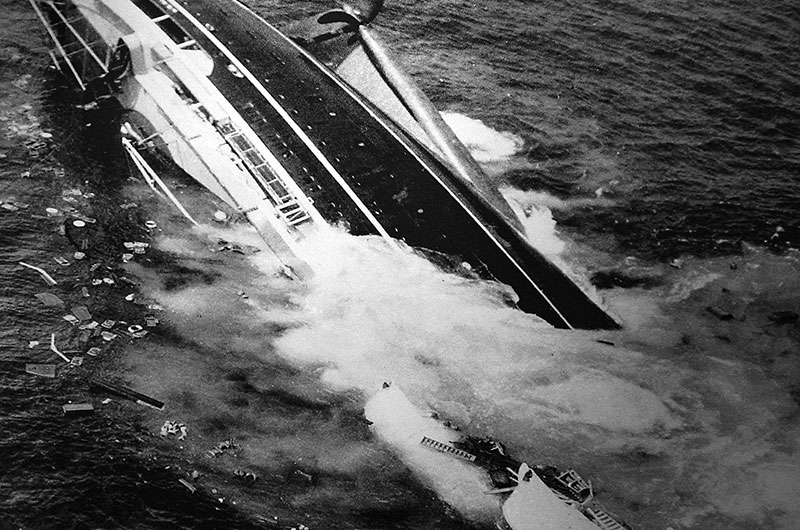~ by Amy Jenness, author of On This Day in Nantucket History, available at Mitchell’s Book Corner ~
The Italian luxury liner Andrea Doria collided with the MS Stockholm in heavy fog off the coast of Nantucket on July 25, 1956 at 11:10 pm. Bound for New York City, the Andrea Doria was struck in the side and the impact ripped a large hole in the side of the vessel. The ship listed so severely to the starboard that half of its lifeboats were unusable. Yet the Andrea Doria’s design allowed it to stay afloat for more than eleven hours while 1,660 passengers and crew members were rescued. In all, 52 people died as a result of the accident. The luxury liner capsized and sank the following morning.
In the mid-1950s, more than 50 passenger liners offered service between Europe and America as part of a postwar boom in transatlantic ocean travel. The lavish Andrea Doria, put into service in 1953, was the pride of the Italian line. The luxury liner was equipped with modern safety systems, such as radar and 11 watertight compartments as part of its hull. The Stockholm, put into service in 1948, was a more modest vessel and carried 747 passengers and crew. The Andrea Doria held 1,706 passengers and crew.
On the night of the collision, the Stockholm had just begun its journey to Sweden while the Andrea Doria was approaching in the opposite direction. The captains of both ships were hard pressed to stay on schedule and running their ship speeds pretty fast. Both captains had spotted each other on their radar systems at roughly 10 miles apart. But they realized they were on a collision course about two miles distant when they were suddenly able to see each other’s lights. The ships were too large and moving too quickly to avoid each other and the Stockholm’s bow rammed into the side of the Andrea Doria, tearing a 30 foot hole in the side.
Five crewmen on the Stockholm were killed instantly. But the Andrea Doria fared worse. The Stockholm’s bow penetrated into the ship’s passenger cabins and 46 passengers and crew were killed. After the crash, the Andrea Doria had seven of its 10 decks exposed to the ocean and in a matter of minutes was listing to the side more than 20 degrees. A lifeboat evacuation began, but did not go smoothly since only 1,044 lifeboat seats were available for the 1,706 people on board. Still functional, the Stockholm lent its lifeboats to the effort and several nearby ships came to assist throughout the night.
Because of the scattering of Andrea Doria passengers among the various rescue vessels, some families became separated. In all, six different ships participated in the rescue of the passengers and crew of the Andrea Doria, including the heavily damaged Stockholm, which was able to steam back to New York under its own power with a United States Coast Guard escort.
During the wait, ABC Radio Network news commentator Edward P. Morgan, based in New York City, broadcast a professional account of the collision, not telling listeners that his 14-year-old daughter had been aboard Andrea Doria and was feared dead. He did not know that Linda Morgan, who was soon labeled the “miracle girl” because she survived being thrown from her bed on the Andrea Doria onto the deck of the Stockholm, was alive. The following night, after learning the good news, his emotional broadcast became one of the more memorable in radio news history.
Among Andrea Doria’s passengers were Hollywood actress Ruth Roman and her three-year-old son, Richard. In the 1950 film Three Secrets, Roman had portrayed a distraught mother waiting to learn whether or not her child had survived a plane crash. Her son and she were separated from each other during the collision and evacuation. Rescued, Roman had to wait to learn her child’s fate which resulted in a media frenzy for photos as she waited at the pier in New York City for her child’s safe arrival aboard one of the rescue ships. Actress Betsy Drake, wife of movie star Cary Grant, also escaped from the sinking liner, as did Philadelphia mayor Richardson Dilworth and songwriter Mike Stoller (of the team Leiber and Stoller).
Assisted by the American Red Cross and news photographers, the frantic parents of four-year-old Norma Di Sandro learned that their injured daughter had been airlifted from the Stockholm to a hospital in Boston, where the previously unidentified little girl had undergone surgery for a fractured skull. They drove all night from New York to Boston, with police escorts provided to their convoy in Rhode Island and Massachusetts. When they arrived, the child was still unconscious and the doctors said all that could be done was wait to see if she woke up. The little girl never regained consciousness, and succumbed to her injuries.
At 10:09 a.m. on July 26, the Andrea Doria sank into the Atlantic. The collision remains the worst maritime disaster to occur in United States waters since the sinking of the SS Eastland in 1915. An out-of-court settlement agreement between the two shipping companies has kept the cause under wraps, but historians believe that both ship captains made errors using their radar, which resulted in the collision.

